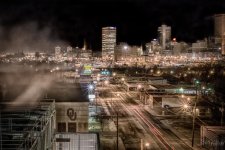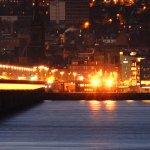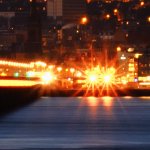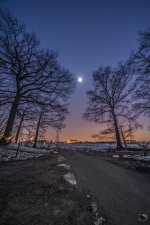Ok, I do not have a city close by to shoot the weekly challenge this week. I thought I could try a little substitution, but it hasn't worked out. I have a power generating plant about 7 miles away (as the crow flies, but over 20 miles by road. It is lit up and stands out well on most nights. I have managed to take pictures of it in the day time and they come out fairly well for the 7 mile distance. Now for night time. I am using the 70-300mm at 300mm. I am on a tripod and using remote shutter control with a 2 second delay. I have tried different shutter speeds and f-stops @ ISO400 with less than satisfactory results.
Now for the question. It is a typical power plant with lots of lights. Would you use a closed down aperture (high f-stop) or wide open aperture to obtain the sharpest, not hazy lights? If I am not mistaken, a closed down aperture tends to give lights a flare, so assuming that I would think better results would be obtained from a wide open setting. Is that true? Along that same line of thinking a faster shutter speed could be used with the wide aperture setting which would help eliminate any camera movement.
Another thing that I noticed in my attempts was that while trying to focus with manual focus and in Live View zoomed in, the lights were difficult to get into focus (focus was very jumpy). Not sure if that would be normal in cold, night conditions. I guess it could be from slight camera shake and the light on the sensor for live view. I didn't try with the viewfinder as I wanted to use the Live View zoom feature. Maybe I should have. Ha!
All input/feedback/suggestions will be appreciated.
Now for the question. It is a typical power plant with lots of lights. Would you use a closed down aperture (high f-stop) or wide open aperture to obtain the sharpest, not hazy lights? If I am not mistaken, a closed down aperture tends to give lights a flare, so assuming that I would think better results would be obtained from a wide open setting. Is that true? Along that same line of thinking a faster shutter speed could be used with the wide aperture setting which would help eliminate any camera movement.
Another thing that I noticed in my attempts was that while trying to focus with manual focus and in Live View zoomed in, the lights were difficult to get into focus (focus was very jumpy). Not sure if that would be normal in cold, night conditions. I guess it could be from slight camera shake and the light on the sensor for live view. I didn't try with the viewfinder as I wanted to use the Live View zoom feature. Maybe I should have. Ha!
All input/feedback/suggestions will be appreciated.




